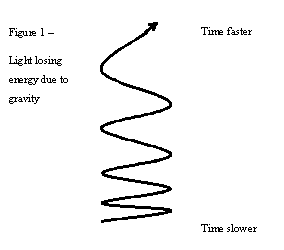Judgement Day (16 page)
Authors: Michael Spears
Tags: #apocalypse, #messiah, #armageddon, #last days, #judgment day, #judgement day

Part 1a: The
Hypothesis
I outline below the
effects of gravitational red shift as mentioned above and draw a
diagram of these two confirmed proposals from the theory of General
Relativity. [Figure 1]

An alternate
explanation for these two experimental results becomes apparent
from visualising the situation. One should consider the possibility
that instead of moving at a constant velocity, light accelerates as
it leaves a stronger gravitational field and enters a weaker
gravitational field, proportional with an increase in the rate at
which time advances.
Thus I have developed
a new definition of time, I will introduce a concept “the speed of
time” (sot), where the sot is the ratio of the time at a certain
location and/or velocity to the time as measured by someone in a
fixed location and/or velocity. The easiest method is if the sot is
measured in the S.I. units of seconds/earth seconds
(s/s
E
), where an earth second could be a second as
measured at a particular location on the earth, like sea level at
the equator or the Greenwich observatory. The sot on earth would
therefore be equal to 1, while in regions where time is faster the
sot is greater than 1 and where time is slower the sot is less than
1.
It is worthwhile to
consider that if time is faster not only do clocks move faster, but
chemical reactions happen faster, flora and fauna age faster, our
brains work faster, so is it not possible that light also moves
faster? According to the aforementioned, any increase in the speed
of light in a vacuum would be unnoticeable because the timing
mechanism that is used to measure the speed of light would also
move faster. If the sot was greater, or “faster,” in a particular
region, then a second (for example) would become shorter and
therefore light would have to travel faster in that shorter second
to cover the same distance as it would cover in a longer second
(where the sot is less).
Thus by this
definition of time the speed of light in a vacuum can appear to
remain constant when the speed of light in a vacuum is not actually
constant at all. However there is one way that a change in the
speed of light is noticed, by the red/blue shift that accompanies
this change in the speed of light.
The hypothesis is that while frequency appears to change,
this is only because our measure of time has changed. The
frequency, and therefore the energy of light remains constant,
however the wavelength has changed.
By this theory’s
definition of time, if time is faster then everything moves faster,
including our clocks and including light.
In the course of this
paper, and my theory as a whole, I will examine some of the
implications of this new interpretation of some old experimental
results and develop a new theory of time and gravity from first
principles.
Part 1b: The Basic
Equations
Let’s begin by
introducing another new definition, “the speed of light as measured
from the perspective of someone on earth,” and give it the value
c
E
measured in the S.I. units of metres/earth second, or
m/s
E
. The energy of light is given by the relation

(1)
(Where E = energy, h =
Planck’s constant, υ
E
= frequency from the perspective
of an observer on earth.)
If we assume by the
first law of thermodynamics that energy is conserved, and if we
also assume that frequency remains constant from the perspective of
someone on earth, then we must first check that the units of
measurement are balanced, so we will now consider the S.I. units of
measurement with regards to this equation.

(2)
If we study equation
(2) we notice that the value for frequency ‘υ
E
’ must
change if time changes, so let’s think about this carefully, the
units for frequency aren’t really ‘1/s
E
’ but
‘waves/s
E
’ and if we take this into consideration while
assuming that the number of waves per second does not change, then
the equation makes more sense.
We could talk about the number of “earth waves” and
consider them to change in proportion to earth seconds, however a
wave is a wave regardless of what your measure of time, an “earth
wave” is no different to simply a “wave”.

(3)
Now we can consider
the Planck constant to be a constant per wave, so it does not
change with time but remains a constant independent of the sot.
However it must be noticed that the units on the left hand side of
equation (3) are not balanced, if ‘s
E
’ changes then the
energy must also change, unless we introduce terms for either
‘kg
E
’ or ‘m
E
’, which are kilograms as
measured from the perspective of someone on earth and metres as
measured from the perspective of someone on earth respectively. Now
we know that either mass or distance must also change when time
changes. Next let’s consider Einstein’s most famous equation but
with the introduced term the speed of light as measured from the
perspective of some on earth ‘c
E
’ while keeping the
units in mind and remembering the first law of thermodynamics, the
law of the conservation of energy

(4)
(Where c
E
=
the speed of light from the perspective of an observer on earth, m
= mass.)
Now we understand that
mass from the perspective of someone on earth must change in
proportion to time from the perspective of someone on earth
squared. In other words, when time becomes faster mass decreases,
from the perspective of someone on earth of course. Let’s rewrite
equation (4) now

(5)
Ignoring the units now
equation (1) is simply the same

(1)
While rewriting
equation (5) without the units is simply

